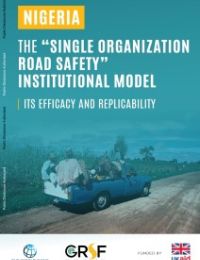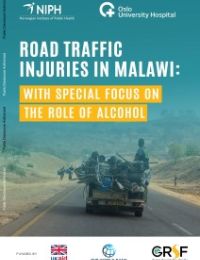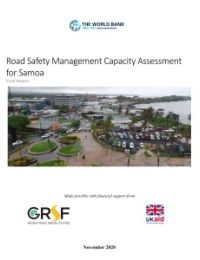Publications
1-3 of 3
-
Road Safety Management
Nigeria: The “Single Organization Road Safety” Institutional Model, its Efficacy and Replicability
July 2022
-
What are the strengths and weaknesses of this model and what could be done to improve its’ efficiency and effectiveness?
-
How efficient and effective is the “Single Organizational Model” institutional setup (both federal and state levels) in dealing with the road safety issues in Nigeria?
-
Can this model be replicated in other LMICs and what are the factors that will determine the replicability of the model in those countries?
-
What are the steps in setting up “Single Organizational Model” institutions in LMICs?
-
Post-Crash Health Care
Road Traffic Injuries in Malawi: With Special Focus on the Role of Alcohol
June 2021
-
Of 1347 eligible patients who were asked to participate during a period of about three months, 1259 (93.5 percent) gave informed consent, eight patients were not tested for alcohol and thus excluded, resulting in 1251 patients in the study.
-
The prevalence of alcohol was 30.7 percent among males and only 2.5 percent among females, who represented 19.2% of the total cases. There were minor differences across different age groups, with the highest prevalence of alcohol use among those between 25 and 44 years of age (26-27 percent) and lowest among those 45 years of age and older (19.7 percent).
-
The highest prevalence of alcohol was found among patients with no formal education (33.3 percent) compared to patients with college or university education (22.1 percent) with the lowest prevalence.
-
When comparing the different road users, the highest prevalence of alcohol was found among pedestrians (41.8 percent) while the prevalence among the other road users varied from 19.1 percent (bicycle riders) to 24 percent (motorcycle riders).
-
Patients injured during weekend night crashes, showed the highest prevalence of alcohol (59.6 percent), followed by those injured during weekend evenings (36.8 percent) and weekday nights (35.3 percent).
-
Regarding drinking habits, measured by the AUDIT-C questionnaire, hazardous drinking was more common among males (26 percent) than among females (4.2 percent). Age group 25-34 years had the highest prevalence of positive AUDIT-C test (26 percent).
-
The blood alcohol concentrations (BACs) at the time of injury were estimated by back-calculation for road users who were tested for alcohol within five hours after injury in accordance with forensic medicine practices. An estimated proportion of 15.2% of the injured motor vehicle drivers had BAC at or above 0.08g/dl when the crash occurred.
-
-
Utilize GRSF recommended methodology to gain a thorough understanding of road safety management capacity;
-
Assess institutional management arrangements as an important focus of the analysis of the road safety system in Samoa;
-
Consider the existing national road safety strategy—Samoa National Action Plan (SNAP) for the Decade of Action for Road Safety 2011-2020—and propose updates for the next period;
-
Provide capacity building on crash investigation and evidence-based road safety measures to ensure success and sustainability, with a focus on vulnerable road users such as females, children, and persons with disabilities; and,
-
Focus on crash data management, including providing hands on capacity building and crash analysis.
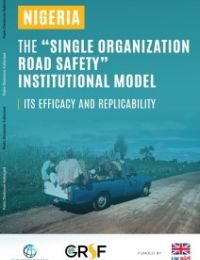
This study is one part of a comprehensive study of lead road safety agencies in low- and middle-income countries (LMICs), which is being conducted on a collaborative basis by the World Bank, the World Health Organization, and the African Development Bank. This particular study is supported by UK Aid through the World Bank’s Global Road Safety Facility (GRSF). It focuses on the case of Nigeria, a federal republic with three tiers of government - federal (central), state and local governments - and its single institutional model for road safety.
This report responds to the following questions:
Download the report to learn more!
RESOURCES ⌵︎
ACKNOWLEDGMENTS ⌵︎
‘The “Single Organization Road Safety” Institutional Model, its Efficacy and Replicability’ Study is supported by UK Aid through GRSF. The Report was written by three main authors: Martin Small, Mustapha Azzouzi and Arpita Roy. The study was led by Farhad Ahmed (Senior Transport Specialist) with support from Md. Towshikur Rahman, who was responsible for the overall coordination.
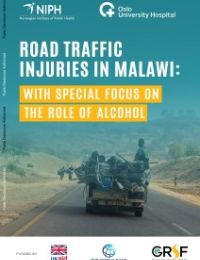
Road traffic crashes are one of the most important causes for physical and psychosocial disease burden and early death worldwide. The United Nations (UN) declared the Decade of Action for Road Safety during the period 2011-2020, with the objective to halve the number of road traffic deaths by 2020. While the number of fatal road traffic crashes has decreased since then in high-income countries (HIC), it has increased in low- and middle-income countries (LMIC). Worldwide, about 90% of the crashes are recorded in LMIC (2016), while these countries had only about 60% of the motor vehicles.
Driving under the influence of alcohol is one of the principal reasons for road traffic crashes. The use of alcohol is also a risk factor for other road users, such as pedestrians and bicyclists. The involvement of alcohol in injurious and fatal road traffic crashes has been well documented in most HICs, but data for LMICs is scarce, particularly for African countries.
The study is a collaborative effort among the Kamuzu Central Hospital (KCH), the Norwegian Institute of Public Health (NIPH) and the Oslo University Hospital (OUH), with the financial support of UK Aid through the Global Road Safety Facility (GRSF), the International Council on Alcohol Drugs and Traffic Safety (ICADTS) and the Norwegian Council for Road Safety (Trygg Trafikk).
The objective of the study was to generate new knowledge about road traffic injuries in Malawi and the extent of traffic accidents related to alcohol use, to increase capacity to conduct alcohol-testing, and develop a database for the findings, which in turn will form the basis for future policymaking to reduce traffic accidents.
The objectives were achieved through collecting data on patients who sought treatment after road traffic crashes and admitted to the Emergency Department at Kamuzu Central Hospital in Lilongwe, Malawi. The data included basic information about the patients, alcohol use before the injury, and information about accident circumstances, including types of road users and vehicles involved. Knowledge and training of local KCH employees to perform alcohol testing and record data were an important aspect of this study.
RESULTS ⌵︎
Acknowledgments ⌵︎
This research project was made possible with the financial support of UK Aid through the Global Road Safety Facility, the International Council on Alcohol Drugs and Traffic Safety and the Norwegian Council for Road Safety.
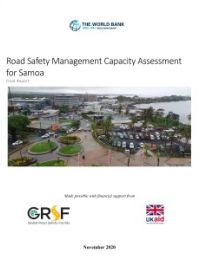
The Road Safety Management Capacity Assessment (RSMCA) is an activity within a broader Advisory Services and Analytics (ASA), which aims to gain a holistic and thorough understanding of the road safety management capacity of three selected Pacific Island Countries (PICs)—Samoa, the Solomon Islands and Vanuatu—in order to support their respective governments to develop national strategies and plans of action to improve road safety outcomes, with a focus on crash data management. The ASA will also support a pilot of the World Bank’s Data for Road Incident Visualization, Evaluation, and Reporting (DRIVER) road crash database in Samoa and provide hands on capacity building in crash analysis.
The ASA is being funded by a Global Road Safety Facility (GRSF) grant from the United Kingdom Agency for International Development (UK AID). The GRSF grant will help the Government of Samoa (GoS) to have a clear image of their road safety situation, risks and challenges, and further on to establish the basis for a national crash database. To ensure sustainability through capacity building and awareness-raising activities, knowledge will be shared with local stakeholders.
The key objectives of this ASA are as follows:
An auxiliary objective is to build capacity to use crash data to identify problems and implement road safety evidence-based measures in Samoa. Furthermore, given the negative impacts of severe weather events on road safety, which will be further exacerbated by climate change, the ASA will help to address the way that road safety is managed in the face of climate change, by training police officers to gain better skills in crash investigation.
The results from the DRIVER pilot in Samoa will be shared with counterparts in selected other PICs, with the aim of scaling up the system across the region. Only with accurate data can road safety be effectively managed and improved, and results measured. In support of this, as of October 2019, the World Bank’s Environmental and Social Framework (World Bank 2019) calls for road safety to be considered on all World Bank-funded projects.
The World Bank is also currently providing assistance to the road sector in Samoa through several projects, including the Samoa Climate Resilient Transport Project (SCRTP), which commenced in 2018. SCRTP will support the GoS to improve the climate resilience of the road network and provide key assistance required to contribute towards effectively managing climate resilient and safe road sector assets. One of the sub-components of SCRTP is dedicated to establishing and operationalizing a database for recording and analyzing road crash data.
The database will combine the existing siloed data, housed in different government agencies, into a single readily accessible platform under the Ministry of Work, Transport and Infrastructure (MWTI). The system will make use of DRIVER, to be piloted through this road safety ASA. SCRTP has other sub-components and activities focused on road safety, such as Road Safety Audits for project roads, a driver licensing training pilot focusing on women, and a road safety engineering technical assistance activity. This GRSF ASA will provide crucial data and insight for the successful delivery of the road safety program under SCRTP, plus other ongoing World Bank-financed projects.

